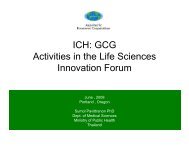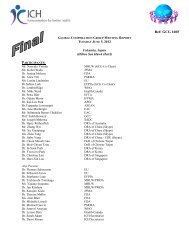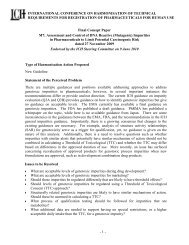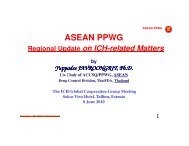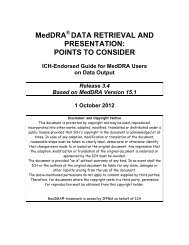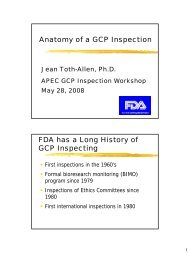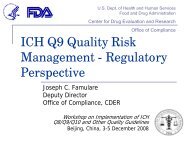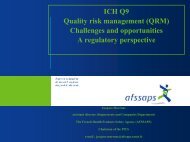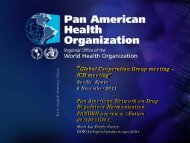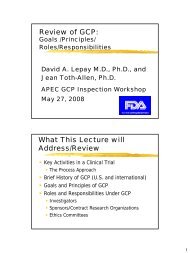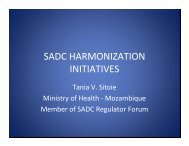Presentation on M7 - ICH
Presentation on M7 - ICH
Presentation on M7 - ICH
Create successful ePaper yourself
Turn your PDF publications into a flip-book with our unique Google optimized e-Paper software.
<strong>ICH</strong> <strong>M7</strong> Guideline <strong>on</strong><br />
Mutagenic Impurities<br />
Warren W. Ku<br />
<strong>ICH</strong> <strong>M7</strong> Rapporteur<br />
Secti<strong>on</strong> Head Integrative Toxicology<br />
Boehringer‐Ingelheim Pharmaceuticals<br />
©2011 <strong>ICH</strong> Internati<strong>on</strong>al C<strong>on</strong>ference <strong>on</strong> Harm<strong>on</strong>isati<strong>on</strong> of Technical Requirements<br />
for Registrati<strong>on</strong> of Pharmaceuticals for Human Use<br />
© 2011 <strong>ICH</strong> 1
<strong>ICH</strong> <strong>M7</strong> Guideline <strong>on</strong> Mutagenic Impurities<br />
Disclaimer:<br />
• The informati<strong>on</strong> within this presentati<strong>on</strong> is<br />
based <strong>on</strong> the presenter's expertise and<br />
experience, and represents the views of the<br />
presenter for the purposes of a training<br />
workshop.<br />
© 2011 <strong>ICH</strong> 2
<strong>ICH</strong> <strong>M7</strong> Guideline <strong>on</strong> Mutagenic Impurities<br />
Basis for addressing mutagenic impurities<br />
• Drug synthetic processes involve the use of reactive<br />
starting materials, intermediates and reagents<br />
o Some are known or potential genotoxicants, carcinogens<br />
o Reacti<strong>on</strong> coupling to generate active pharmaceutical<br />
ingredient (API)<br />
• Low levels of mutagenic impurities may appear in<br />
the final drug substance or product<br />
• How do we manage risk and quality, both during<br />
drug development and post-registrati<strong>on</strong>?<br />
© 2011 <strong>ICH</strong> 3
<strong>ICH</strong> <strong>M7</strong> Guideline <strong>on</strong> Mutagenic Impurities<br />
History<br />
2000-2004<br />
2004<br />
o <strong>ICH</strong> Q3A/B (R) issued in 2002<br />
– “Lower thresholds may be appropriate for unusually toxic impurities”<br />
– Lacks specific guidance <strong>on</strong> how to address mutagenic/carcinogenic impurities<br />
o Increased awareness and regulatory scrutiny <strong>on</strong> residual levels of<br />
genotoxic impurities in API and drug products<br />
o EMEA issues draft guidance, stressing avoidance vs. acceptance of a low<br />
limit<br />
o<br />
2005<br />
o<br />
EMEA updates draft guidance and introduces the TTC limit (1.5 ug/day)<br />
for drugs<br />
PhRMA Publicati<strong>on</strong> (Müller et al., 2006). “A rati<strong>on</strong>ale for determining,<br />
testing and c<strong>on</strong>trolling specific impurities in pharmaceuticals that possess<br />
potential for genotoxicity”<br />
– Introduces c<strong>on</strong>cept of the ‘staged TTC’ for clinical trial materials<br />
© 2011 <strong>ICH</strong> 4
<strong>ICH</strong> <strong>M7</strong> Guideline <strong>on</strong> Mutagenic Impurities<br />
History (c<strong>on</strong>tinued)<br />
2007<br />
o<br />
o<br />
2008<br />
o<br />
o<br />
CHMP Guideline <strong>on</strong> the Limits of Genotoxic Impurities effective January<br />
2007.<br />
CHMP Q&A document generated based <strong>on</strong> industry questi<strong>on</strong>s and EMA<br />
answers<br />
FDA Draft Guidance for Industry. Genotoxic and Carcinogenic Impurities<br />
in Drug Substances and Products: Recommended Approaches.<br />
EMA letter requesting evaluati<strong>on</strong> of sulf<strong>on</strong>ate esters in all marketed<br />
products<br />
2009-10<br />
o<br />
o<br />
o<br />
November 2009 – C<strong>on</strong>cept paper issued and <strong>ICH</strong> <strong>M7</strong> topic agreed<br />
September 2010 – CHMP Q&A document updated<br />
November 2010 – First <strong>ICH</strong> EWG <strong>M7</strong> Meeting in Fukuoka Japan<br />
© 2011 <strong>ICH</strong> 5
<strong>ICH</strong> <strong>M7</strong> Guideline <strong>on</strong> Mutagenic Impurities<br />
Threshold of Toxicological C<strong>on</strong>cern (TTC)<br />
c<strong>on</strong>cept as a basis for characterizing risk<br />
• Pragmatic approach for establishing an exposure threshold for all<br />
chemicals below which there is no appreciable risk to human health (e.g.<br />
cancer)<br />
o<br />
For drugs, TTC limit established at 1.5 ug/day (1 in 100,000 cancer risk) (CHMP)<br />
• For carcinogenicity, it is based <strong>on</strong> the more potent carcinogens<br />
o<br />
o<br />
Carcinogenic potencies range over 100 milli<strong>on</strong> fold.<br />
Many genotoxic carcinogens are lower potency, so "risk" level much lower than 1 in<br />
10 5<br />
• Linear extrapolati<strong>on</strong> from rodent carcinogenic dose<br />
o<br />
o<br />
Most sensitive sex, species and site of tumors<br />
No allowance for threshold<br />
• Lifetime exposure assumed (70 years)<br />
o<br />
Most drugs are not given for a lifetime<br />
o<br />
Staged TTC: C<strong>on</strong>siders less than lifetime exposures (e.g. clinical development)<br />
© 2011 <strong>ICH</strong> 6
<strong>ICH</strong> <strong>M7</strong> Guideline <strong>on</strong> Mutagenic Impurities<br />
<strong>ICH</strong> <strong>M7</strong> Topic for Harm<strong>on</strong>izati<strong>on</strong><br />
• Deliverable (<strong>M7</strong> Business Plan): Harm<strong>on</strong>ized<br />
guideline for evaluati<strong>on</strong> and c<strong>on</strong>trol of mutagenic<br />
impurities<br />
o What are acceptable limits during development and<br />
marketing?<br />
o Regulated using threshold of toxicological c<strong>on</strong>cern (TTC)<br />
approach?<br />
o Treating multiple impurities?<br />
o Addressing impurities that are metabolites<br />
o Situati<strong>on</strong>s and data to support excepti<strong>on</strong>s for higher<br />
acceptable daily intakes than the TTC?<br />
© 2011 <strong>ICH</strong> 7
<strong>ICH</strong> <strong>M7</strong> Guideline <strong>on</strong> Mutagenic Impurities<br />
<strong>M7</strong> Expert Working Group (EWG)<br />
Party Topic Leader Deputy Topic<br />
Leader<br />
Expert Observer Interested<br />
Party<br />
EU Peter Kasper Diana van Riet-<br />
Nales<br />
EFPIA Steven Spanhaak Lutz Muller Kevin McKiernan<br />
MHLW Masamitsu H<strong>on</strong>ma Yukio Aso Mari Yoshitomi<br />
JPMA Shigeki Sawada Tom<strong>on</strong>ori K<strong>on</strong>se Kazusei Komatsu<br />
FDA David Jacobs<strong>on</strong>-Kram Stephen Miller Aisar Atrakchi<br />
PhRMA Warren Ku David De Ant<strong>on</strong>is Joseph DeGeorge<br />
EFTA Elisabeth Klenke<br />
HC Alisa Vespa<br />
WSMI Esther Vock<br />
IGPA Jack Lipman<br />
DRA of<br />
Sun Tao<br />
China<br />
DRA of<br />
Singapore<br />
Looi Yee Hoo<br />
Invited RHI/DRA/DoH representatives: Mr. Zhang Wei and Dr. Chen Zhen, DRA China<br />
© 2011 <strong>ICH</strong> 8
<strong>ICH</strong> <strong>M7</strong> Guideline <strong>on</strong> Mutagenic Impurities<br />
Draft <strong>ICH</strong> <strong>M7</strong> Guideline Title<br />
• Assessment and C<strong>on</strong>trol of DNA Reactive (Mutagenic)<br />
Impurities in Pharmaceuticals to Limit Potential<br />
Carcinogenic Risk<br />
o Objective was to place focus <strong>on</strong> limiting carcinogenic risk of<br />
low level DNA-reactive mutagenic impurities<br />
© 2011 <strong>ICH</strong> 9
<strong>ICH</strong> <strong>M7</strong> Guideline <strong>on</strong> Mutagenic Impurities<br />
Issues for <strong>M7</strong> Guideline Development<br />
• Refine c<strong>on</strong>siderati<strong>on</strong>s and elements for c<strong>on</strong>ducting assessments<br />
o From clinical development to post-marketing scenarios<br />
o<br />
Retrospective applicati<strong>on</strong> of the guideline (e.g. process route changes)<br />
• Use of predictive in silico tools to identify structures of c<strong>on</strong>cern to<br />
base further assessments <strong>on</strong><br />
o<br />
Assessment elements, process, what and how many tools to use?<br />
• Applicati<strong>on</strong> of TTC c<strong>on</strong>cepts and c<strong>on</strong>siderati<strong>on</strong> of alternative risk<br />
approaches to limit carcinogenic risk<br />
• Defining important elements in a c<strong>on</strong>trol strategy of mutagenic<br />
impurities<br />
o From the use of process understanding and ‘quality by design’ principles<br />
to end product testing<br />
© 2011 <strong>ICH</strong> 10
<strong>ICH</strong> <strong>M7</strong> Guideline <strong>on</strong> Mutagenic Impurities<br />
<strong>ICH</strong> <strong>M7</strong> EWG Progress and Status<br />
• General timelines<br />
o Targeting Step 1 first draft June 2011<br />
o Target date for Step 2 document Nov 2012<br />
• Step 1 starting working draft developed Dec 2010<br />
• Some members attended and presented at the April 2011 DIA QSAR<br />
Workshop – in silico approaches<br />
• Elluminate Live! meetings held (May 2011) to prioritize key topic areas<br />
where data/informati<strong>on</strong> and further discussi<strong>on</strong>s are needed to reach an<br />
agreed positi<strong>on</strong><br />
• EWG Meeting (Cincinnati) (June 13-16)<br />
o Assemble case examples and alternative positi<strong>on</strong> proposals to present, review and<br />
discuss. Establish agreed positi<strong>on</strong>s. (Day 1)<br />
o Revise/c<strong>on</strong>struct remaining Step 1 draft secti<strong>on</strong>s towards completi<strong>on</strong> of 1 st draft<br />
(Days 2-4)<br />
© 2011 <strong>ICH</strong> 11
Thank You!<br />
©2011 <strong>ICH</strong> Internati<strong>on</strong>al C<strong>on</strong>ference <strong>on</strong> Harm<strong>on</strong>isati<strong>on</strong> of Technical Requirements<br />
for Registrati<strong>on</strong> of Pharmaceuticals for Human Use<br />
© 2011 <strong>ICH</strong> 12




